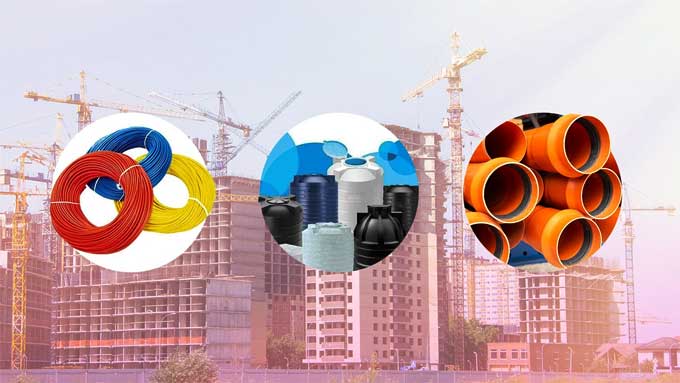
Is Plastic Useful in Construction Industries?

Plastic has becomes a necessary component of our daily lives. The usage of plastic is steadily rising each year. Here, we'll talk about everything related to plastic as a building material and determine whether it may alter the way we see buildings.
Cattle horns were employed as lantern windows in the Middle Ages, while expanded polystyrene, was utilized to insulate houses. The usage of plastics is being adjusted as technology advances while taking into account their characteristics, benefits, and drawbacks.
In the case of developed economies, one-third of plastic is used in packaging and also in buildings in the form of components such as plumbing. With many advantages, plastic has become a part of our daily lives. It is also one of the most widely used construction materials too.
Benefits of Plastic in Construction
Plastic has the following advantages:-
1. As they are not biodegradable, plastics are strong and may survive for a very long time.
2. Plastics have excellent strength and hardness, which prevents them from losing their shape.
3. Plastics are produced at a low cost and are readily accessible to consumers who are building homes.
4. Because of their high energy density, plastics may be burned in an incinerator, which can be quite beneficial in specific circumstances.
5. As they are not subject to termite attack like wood is, plastic ornamental laminates are well recognized for use in furniture or paneling.
6. Buildings' dead loads are reduced, preventing them from becoming too heavy when constructed using conventional materials.
7. In the case of plumbing projects, in the example, they may be easily linked with other plastics and reused if disassembled.
8. In landfills, plastics don't take up much room. Plastic products take longer to degrade in landfills than other materials, although they take up less room overall when compared to other goods. Paper items consume seven times more volume than plastic products.
9. When plastics are disposed of in landfills, methane is not exposed to the air. Plastics do not release methane gas as they begin to degrade, which suggests that it is simpler to determine with accuracy how long a plastic product will endure overall. It can be used for demolition.
Application of Plastic in Construction
1. Manhole covers, fittings, and pipes in the plumbing
2. Construction of roofs
3. Wall panels for drywall or wall partitions
4. Electrical appliances
5. Furniture such as chairs and tables
6. Locks and shutters
7. Floating floors
8. membranes that are waterproof
9. panels for fake ceilings
10. Adhesives
11. water reservoirs.
Drawbacks of Plastic in Construction
Plastics have some disadvantages, including the following:
1. It is difficult to use plastics in structural elements or hot water systems at high temperatures because they tend to soften at high temperatures.
2. The plastic may grow brittle in cold areas and crack under strain. Therefore, it is advised against using it in cold weather.
3. Since many plastics are difficult to recycle, there is concern about how they will degrade because many of them take millions of years.
4. Due to their low elastic modulus, plastics are inappropriate for load-bearing applications like beams and columns.
5. Plastic makes up the bulk of the pollution in the world's oceans, which is killing all kinds of wildlife since they eat plastic.
6. While plastics may be cheaper, they have a detrimental impact on people, which is why they are more expensive.
7. Despite the fact that plastic is fireproof, many varieties do not allow adequate thermal movement because they have high thermal expansion rates.
Properties of Plastic
A number of properties have led to plastic's increased use in construction, including:
In addition, it is corrosion-resistant and requires minimal maintenance, which is essential for structures because of its strong ability to ward off the impacts of the weather.
This is accomplished using the chemical polyphenylene sulfide, which is present in plastic. Most of its applications involve extremely high temperatures and caustic chemicals.
It has the capacity to create tight seals that would ordinarily prevent any liquid from passing through it and into other materials. Its structure, to put it simply, makes it impervious. Polymeric chains are formed to create them. A building with such construction has superior water repellence, which aids in making the structure leakproof.
It is fire-resistant, and antimony trioxide is combined with a brominated chemical to create polyethylene for this during processing.
In order to increase the fire-retardant qualities of brominated chemicals, antimony trioxide works well with them. By slowing down combustion, this is accomplished.
Due to the fact that plastic is anti-vibration in nature, it can withstand enormous deflections, such as those caused by earthquakes, without deforming. Because of this, the building's seismic performance has improved.
Plastic's strength and lightweight characteristics make it an ideal material for use in construction since they facilitate transportation, loading and unloading, installation, etc.
To learn more, watch the following video tutorial.
Video Source: GIZ
Plastic is a fantastic material for thermal insulation, and this may be accomplished by including foamed plastic sheets inside the building.
Wrapping it
Without a question, the most innovative product in recent memory is plastic. Its uses in structures are changing along with the periods, and in the future, some unexpected uses in buildings, such as used in various climatic conditions or as load-bearing elements, may occur.
These industrialized nations are using more plastic than ever before. Plastics will thus be the preferred material for home construction in the future.


